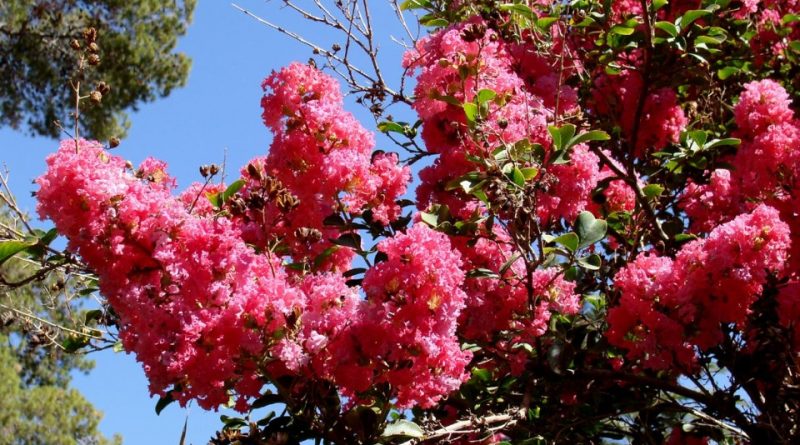Lagerstroemia indica
Lagerstroemia indica
Crispy Myrtle or Lilac of the Indies (Lagerstroemia indica L., 1759) is an arboreal species belonging to the family Lytraceae.
Systematics –
From the systematic point of view it belongs to the Domain Eukaryota, Kingdom Plantae, Subarignus Tracheobionta, Division Magnoliophyta, Class Magnoliopsida, Sottoclasse Rosidae, Order Myrtales, Family Lythraceae and then to the Genus Lagerstroemia and to the Species L. indica.
Etymology –
The term Lagerstroemia was dedicated to Magnus von Lagerstroem (1696-1759), a Swedish naturalist, a friend of Linnaeus. The specific epithet indicates is in fact improper as this species is native to China.
Geographic Distribution and Habitat –
Lagerstroemia indica is a tree native to South-East Asia (temperate zone of China) which is present spontaneously also in Java, Laos, Thailand, Vietnam, Cambodia and the Andaman Islands. Currently it is present in various parts of the world where it was introduced by man.
Description –
Crispy Myrtle is a small tree, or deciduous shrub that does not exceed 8 meters in height and has a rounded, light foliage with spread branches. It has a ribbed trunk, wider at the base and covered with a thin yellowish white peel with darker plates. The leaves are up to 7 cm long and are deciduous, opposite, distical with an elliptic lanceolate lamina, with an acute apex. The upper page has a glossy and dark green consistency, while the lower one is clearer and opaque.
It produces some showy terminal panicles, with flowers a few inches wide and with a glass of six sepals and a corolla of six petals with a thin and elongated fingernail and an elegantly waved flap. The color of the flowers varies from purple to white and the flowering period is in summer.
The fruit is a septemragous capsule that opens incompletely along the dorsal or ventral sutures of the carpels, due to the breaking of the internal septa close to the central persistent axis of the fruit still visible after the opening of the valves. The seeds are small.
Cultivation –
Lagerstroemia indica is a perennial deciduous tree that can be grown as a shrub or tree. The plant requires exposures in sunny or semi-gloomy places, with clayey or calcareous soils, rich in organic substance and well drained. The plants cultivated in the ground are satisfied with the rains; species grown in pots require moist soil and frequent watering during periods of prolonged drought.
While for fertilization every 3 -4 months administer at the foot of the plant slow-release fertilizer. During the winter, fertilize at least once with a mature manure. Fertilization should never be suspended, even when the plant is adult.
Lagerstroemia indica reproduces by seed or by cuttings. Seeds collected at the end of summer are sown in autumn or spring. The cuttings are prepared in the period July-August, taking twigs of the year 20 cm long and placed to root in moist soil, composed in equal parts of peat and sand. The rooted cuttings should be planted after 2 – 3 years of cultivation in pots.
Uses and Traditions –
Lagerstroemia indicates for its beautiful flowering, which lasts from July to September, it is widely used as ornamental in parks and gardens and also in road trees. Many varieties have been selected that differ in color and posture.
Preparation Mode –
Lagerstroemia indica has no particular uses for food or pharmaceutical purposes.
Guido Bissanti
Sources
– Acta Plantarum – Flora of the Italian Regions.
– Wikipedia, the free encyclopedia.
– Treben M., 2000. Health from the Pharmacy of the Lord, Advice and experience with medicinal herbs, Ennsthaler Publisher
– Pignatti S., 1982. Flora of Italy, Edagricole, Bologna.
– Conti F., Abbate G., Alessandrini A., Blasi C. (edited by), 2005. An annotated checklist of the Italian vascular flora, Palombi Editore.
Warning: Pharmaceutical applications and alimurgical uses are indicated for informational purposes only and do not in any way represent a medical prescription; there is therefore no liability for their use for curative, aesthetic or food purposes.


